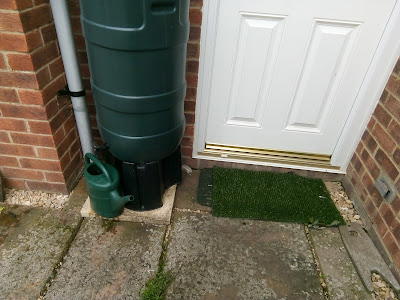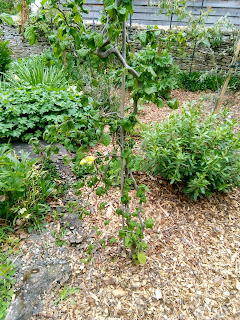Sloping gardens can be a dreadful nuisance: the soil erodes, the plants fall down, and gardening can become really tiring, because you always seem to be going uphill with a heavy wheelbarrow.
Usually, the only sensible option is to have it terraced:
This is one where the bank was so steep that nothing would grow, apart from brambles, self-set Sycamores, Wild Plum, and an underplanting of nettles.
So the Owner had the main trees cut down - you can see where their stumps interrupt the neat terraces! - and had substantial solid wood log edging installed to break the slope up into 8 level beds, of slightly varying heights and depths.
This was deliberate, to prevent it looking too artificial, and gave me a series of beds to accommodate different plants.
(And yes, I did have a word with the firm who installed it, and specified that no one terrace was to be more than knee-high to me, so that I would be able to clamber up it!)
Yes, it cost quite a lot of money, but once installed, it opened up a huge area of garden: and as the new terraces were filled with brought-in topsoil, it gave us some wonderful top quality planting areas. And it has lasted for years....
However, not every slope requires this level of construction, not every Client can afford a major landscaping job: and sometimes the size of the planting doesn't really warrant a lot of work.
But planting on a very steep slope always requires some sort of intervention, otherwise the soil washes away, and the plant either dies of thirst, or falls over and tumbles down the hillside.
Here's one solution:
The slope here was so steep that hardly anything could grow, but the Client wanted some Buddleia and some Mallow, to brighten up the hillside.
Both of these are good choices: once they get established, they are both as tough as old boots, especially the Buddleia.
But they would need some help in getting established, so I decided on a two-pronged approach.
Firstly, I asked the Client to buy small plants - this might seem contradictory, but small plants find it easier to establish, especially in difficult situations. They have less upper growth to support: they are less likely to be blown or pushed over. by weather and wildlife: and they are less likely to die of drought, than a larger plant.
And secondly, I built some rustic mini-terraces, using some offcuts of half-round edging and some odd bits of wood which I found in the shed. I sharpened the "stakes", and hammered them in, then I chipped out a hole in the hillside behind each one, and filled it with really thick home-made compost. These chipped-out holes were dug into the hillside in such a way as to be deeper at the "back", ie the left of this photo, than the front edge. The idea being that any rain, or dew, would be caught by the softer soil, and would trickle back into the hole, rather than simply spilling out and running off downhill.
I then planted into those "pockets", and watered until I couldn't get any more water in. And it worked perfectly, the plants established themselves with minimal care from the owner, and for all I know, are still there today.
In another situation, I was faced with another very steep slope, and a request to plant an ornamental shrub. This time, I made use of a lot of old bricks and stones which I found within the bank, and built my own mini-terrace:
Not exactly artisan craftsman work, but it did the job: I chipped away some of the bank, until I found reasonably hand earth: I carved out a narrow platform on this hard earth, then built a staggered wall of bricks.
The odd bits of stone were used as wedges, to create a wall which sloped inwards, towards the slope - that's to the right, in this photo. It may appear to be more or less upright, but it isn't! It's leaning inwards.
This was to ensure that the whole thing didn't topple outwards under the weight of the soil.
Having built the wall, I then brought in some decent soil, with as much heavy organic matter as I could find, to aid with water retention, which is always an issue when planting on a steep slope. I did consider lining the inside of my mini-terrace wall with plastic, to hold more moisture inside it: but in the end, I decided that it was probably big enough to sustain itself.
Once the soil was in place, I simply planted the shrub, watered it in well - very well - and took care to check that the surface of the new plateau was levelled in such a way that all water approaching this area will sit on top of the plateau, and won't run straight off it.
You can easily check this when you water in the plant(s) - if you are trying to water them, and the water is all running off over the lip of your plateau, then you need another layer of walling, or you need to remove more material from the uphill side of it.
Keep adjusting it, until any water runs to the middle of the area, more or less where the shrub is. This ensures that every drop of rain, dew, fog or mists will go where it will do the most good.
In all these cases, the plan is that your temporary terracing will last long enough for the planting to get its roots down into the bank, where it will find firm foundations, and quite possibly will also have access to the water resources of the bank itself. So, by the time the wood, or the bricks, or whatever you have used, is starting to fall apart, the planting is big enough to just keep on growing.
Did you enjoy this article? Did you find it useful? Would you like me to answer your own, personal, gardening question? Become a Patron - just click here - and support me! Or use the Donate button for a one-off donation. If just 10% of my visitors gave me a pound a month, I'd be able to spend a lot more time answering all the questions!!















